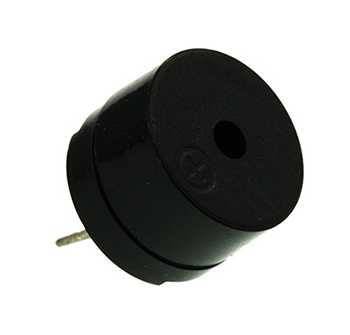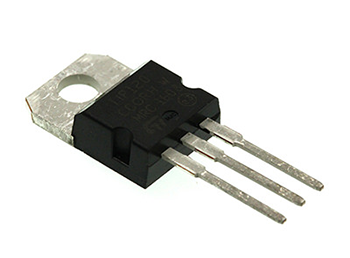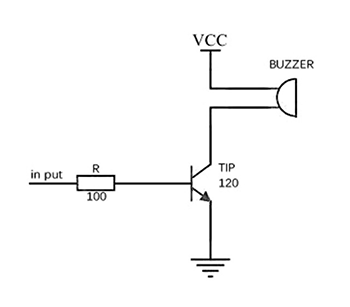Case 09: Buzzer
Contents
11. Case 09: Buzzer#

11.1. Introduction#
The buzzer is an integrated structure of electronic sounders, widely used as sounding devices in computers, printers, photocopiers, alarms, electronic toys, automotive electronics, telephones, timers and other electronic products. In this lesson, we use Pico:ed to drive the buzzer and make it sound different syllables as an alarm.
11.2. Components List#
Hardware#
1 × Pico:ed
1 × USB Cable
1 × Breadboard Adapter
1 × 83×55mm Breadboard
1× Buzzer
1X NPN Transistor
1× 100Ω Resistors
N* Dupont Cables
11.3. Main Components#
Buzzer#
The buzzer is a sound producing device, which consists of a vibrating and resonating device. The buzzer can be subdivided into active and passive types according to the type of control.

The active type buzzer works on the principle of sound generation: the buzzer has an integrated internal oscillation system and an amplification sampling circuit, which causes the resonant device to generate a sound signal when a DC power supply passes through the buzzer.

A passive type buzzer works on the principle of sound generation: a square wave signal is input to the resonant device and converted into an acoustic signal output, the working sound generation principle of a passive type buzzer is as follows.

Note: For this project, we are using a passive buzzer.
11.4. Transistor#
A transistor is a semiconductor device that controls current and serves to amplify weak signals into electrical signals with a large amplitude value.

If the PWM signal generated by the Pico:ed is fed directly into the buzzer, the buzzer will only emit a weak sound because the drive current of the IO port is usually too weak to drive a device like the buzzer. This is where we need to use a transistor to amplify the current from the PWM signal so that the buzzer can make a normal sound. A typical application circuit for driving a buzzer with a transistor is as follows.

11.5. Steps#
Hardware Connection#
Connect the components as the pictures suggest:
1.Connect the buzzer in series with the 100Ω resistor and the transistor to the P0 port

This is the picture after finishing the connections:
11.6. Programming#
Program Preparation: Prpgramming environment
Sample Code:#
# Import the modules that we need:
import board
import pwmio
import time
# Set the pins used for buzzer and the play tones of the buzzer
piezo = pwmio.PWMOut(board.P0_A0, duty_cycle=0,frequency=440, variable_frequency=True)
def play_note(note):
piezo.frequency = note
piezo.duty_cycle = 65535 // 2
time.sleep(0.25)
piezo.duty_cycle = 0
time.sleep(0.05)
# While true, play the tones
while True:
play_note(494)
time.sleep(0.2)
play_note(262)
time.sleep(0.2)
play_note(294)
time.sleep(0.2)
Details of the Code:#
Import the modules that we need.
boardis the common container, and you can connect the pins you’d like to use through it. Thepwmiomodule contains classes that provide access to the basic pulse IO and thepwmiomodule contains classes that provide access to the basic pulse IO.
import board
import pwmio
import time
Set the pins used for buzzer and the play tones of the buzzer
piezo = pwmio.PWMOut(board.P0_A0, duty_cycle=0,frequency=440, variable_frequency=True)
def play_note(note):
piezo.frequency = note
piezo.duty_cycle = 65535 // 2
time.sleep(0.25)
piezo.duty_cycle = 0
time.sleep(0.05)
If the pins you are using are not P0_A0, the other pin numbers can be viewed by entering the following code in the shell window below the Thonny editor.
>>> import board
>>> help(board)
object <module 'board'> is of type module
__name__ -- board
board_id -- elecfreaks_picoed
BUZZER_GP0 -- board.BUZZER_GP0
I2C0_SDA -- board.BUZZER_GP0
I2C0_SCL -- board.I2C0_SCL
BUZZER -- board.BUZZER
BUZZER_GP3 -- board.BUZZER
P4 -- board.P4
P5 -- board.P5
P6 -- board.P6
P7 -- board.P7
P8 -- board.P8
P9 -- board.P9
P10 -- board.P10
P11 -- board.P11
P12 -- board.P12
P13 -- board.P13
P14 -- board.P14
P15 -- board.P15
P16 -- board.P16
SDA -- board.SDA
P20 -- board.SDA
SCL -- board.SCL
P19 -- board.SCL
BUTTON_A -- board.BUTTON_A
BUTTON_B -- board.BUTTON_B
SMPS_MODE -- board.SMPS_MODE
VBUS_SENSE -- board.VBUS_SENSE
LED -- board.LED
P0_A0 -- board.P0_A0
P0 -- board.P0_A0
A0 -- board.P0_A0
P1_A1 -- board.P1_A1
P1 -- board.P1_A1
A1 -- board.P1_A1
P2_A2 -- board.P2_A2
P2 -- board.P2_A2
A2 -- board.P2_A2
P3_A3 -- board.P3_A3
P3 -- board.P3_A3
A3 -- board.P3_A3
While true, play the tones
while True:
play_note(494)
time.sleep(0.2)
play_note(262)
time.sleep(0.2)
play_note(294)
time.sleep(0.2)
11.7. Result#
The buzzer alarms and repeats in the specific tones.
11.8. Exploration#
How to program if we want to alarm for high temperature with the TMP36 sensor and the buzzer?
